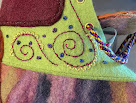It may be because its fall with the fading light and the increasing cold or any number of other reasons but I find myself in the throes of making decisions re my studio practice - yet again. I have been here before - when I question what is the purpose of creating more work? why does nothing seem interesting? why did I take that workshop, why am I holding on to these supplies, why, why, why.
And I definitely know that the whole creative process is a series of ups and downs. But - this time it seems deeper. Maybe this time I will really decide that keeping the studio is not a good idea. That I really should get rid of those supplies I don't use, that Sweet Sixteen handi quilter, those print making supplies, those old projects.
Maye it is really time to go to Palm Desert in a couple of months with NO projects. Could I walk away for 3 months? Could I walk away period?
I would love to hear how others have made their decisions in this area - what helped you make a firm decision instead of waffling back and forth.
Barbara Schneider















